First impressions: John Deere’s bonkers-big 913hp 9RX 830
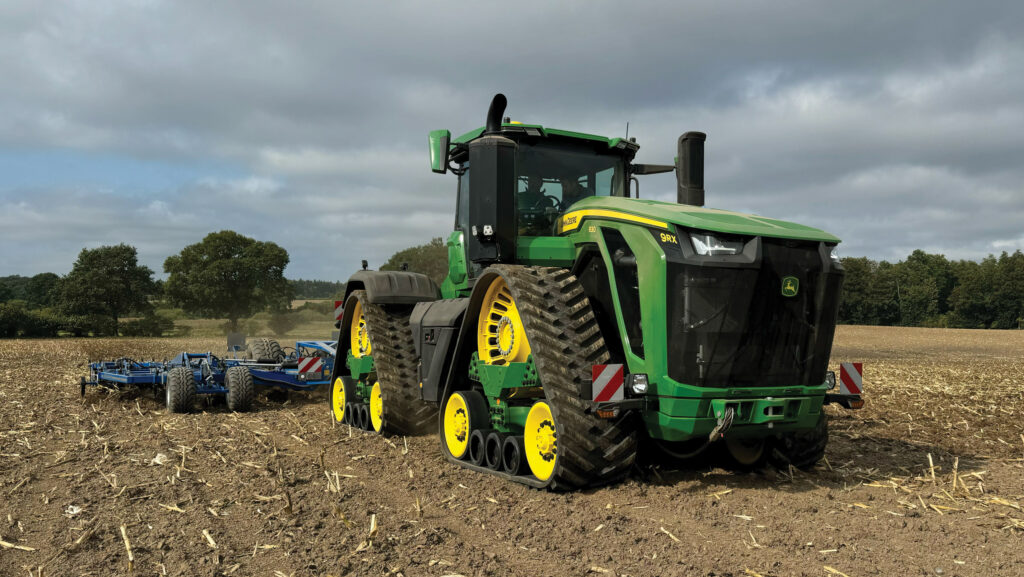 © MAG/Oliver Mark
© MAG/Oliver Mark John Deere’s new 9RX 830 is the biggest, most powerful and most expensive tractor ever to go into series production.
In pure horsepower terms, it can be bettered only by the 1,100hp custom-built Big Bud of the late 1970s.
Needless to say, the brochure accompanying Big John contains enough mind-boggling numbers to give Carol Vorderman the sweats, whether it’s the heady 913hp output, the colossal 38t ballasted weight, or – brace yourself – the downright frightening £917,000 list price.
See also: First impressions – how does 778hp Case Quadtrac shape up?
There is more to these figures than meets the eye, of course.
While the sheer weight will send shudders down the spines of soil evangelists, long tracks and even balance will, by Deere’s reckoning, have it treading almost impossibly lightly.
And as shocking as the price may seem, many farmers acquainted with the upper echelons of the tractor market are almost resigned to the fact that horsepowers cost nearly £1,000 apiece.
John Deere 9RX 830
- Engine 18-litre, six-cylinder JDX18
- Max power 913hp
- Max torque 4,234Nm
- Transmission E21 full powershift (40kph)
- Hydraulics Twin 212 litre/min pumps for 424 litre/min (636 litre/min option)
- Wheelbase 4.62m
- Turning circle 19.6m
- Base weight 33,500kg
- Max gross vehicle weight 42,180kg
Nonetheless, few in our fair land will have access to the financial levers required to afford such hellacious power – not to mention the implements to go with it and fields big enough to warrant it.
Where does it fit it?
There are three new models in the 9RX range, joining an existing four.
The old guard comprises the 9RX 490, 540, 590 and 640, which offer comparatively modest outputs ranging from 539hp to 691hp.
In North America, all of these are dead certs to be cannibalised by the newcomers – the 9RX 710 (781hp), middling 770 (847hp) and 913hp 830.
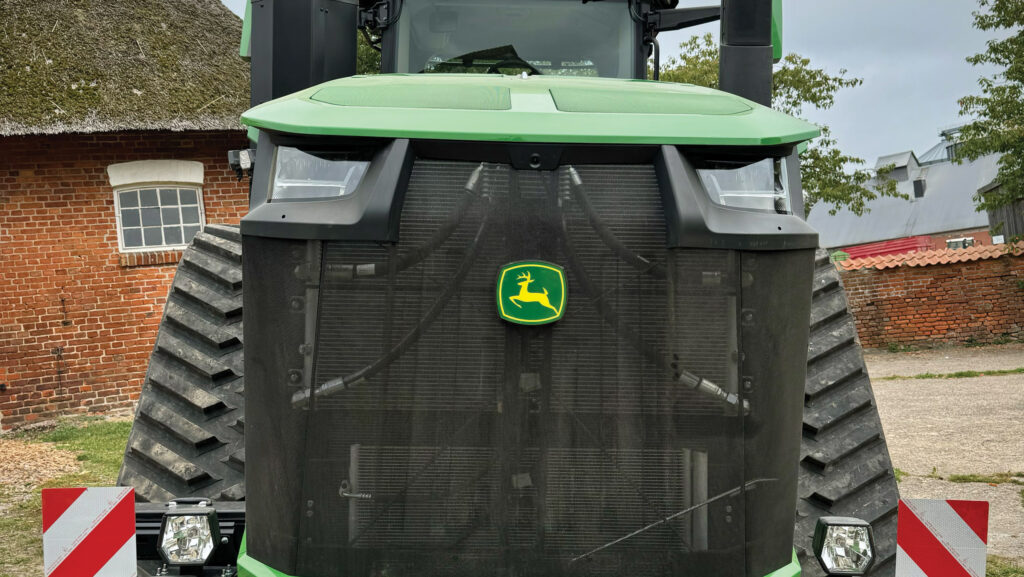
© MAG/Oliver Mark
They look and feel like entirely different beasts, with noses so big they could smell a Sunday roast on a Tuesday, hundreds more horsepower, and a new drivetrain, undercarriage and cab.
Such is their size that, head on, they appear almost as caricatures of their “smaller” relatives, and they’re almost half-a-metre longer to boot.
Outside of the John Deere stable, the high-horsepower landscape has been in an unusual state of flux over the past 12 months, with several new models hitting the market.
List prices
- 9RX 640 – £683,816
- 9RX 710 – £789,807 (base); £866,409 (full spec)
- 9RX 770 – £815,109 (base); £891,711 (full spec)
- 9RX 830 – £840,410 (base); £917,012 (full spec)
Of those, Claas’ nearest offering, the Xerion 12.650, comes in at 653hp (six-cylinder, 15.6-litre). A rival to the ageing 9RX 590, maybe?
And the new Case IH Quadtrac 715 tops out at 778hp (six-cylinder, 16-litre), which makes it a match for the “small” 9RX 710.
In short, the two biggest 9RXs have no competition, at least as far as outright horsepower goes.
Deere expects these to sell in their thousands, though only a fraction will wind up in western Europe, and even hardly any will make it to the UK.
What’s new?
Power, obviously – up 222hp from the previous flagship 640 to the new range-topper.
This has been achieved by swapping the 13.6-litre engine for a dual-turbo 18-litre unit used in Deere’s forage harvesters.
With six bores the size of badgers’ burrows, it takes two starter motors with a combined 15hp just to get the pistons pumping.
A 10% power bulge pushes the 830hp rated output up to that heady 913hp figure, and torque tops out at 4,234Nm to better that of a Challenger 2 tank. Firepower, indeed.
And because all three models kick out more than 750hp, they fall into a more lenient emissions category as far as NOx and particulates are concerned.
This means they can go without a soot catalyst, AdBlue and all the associated trouble-prone sensors.
Plenty of farmers will consider the avoidance of this sanity-testing paraphernalia to be a perk worth several thousand pounds alone.
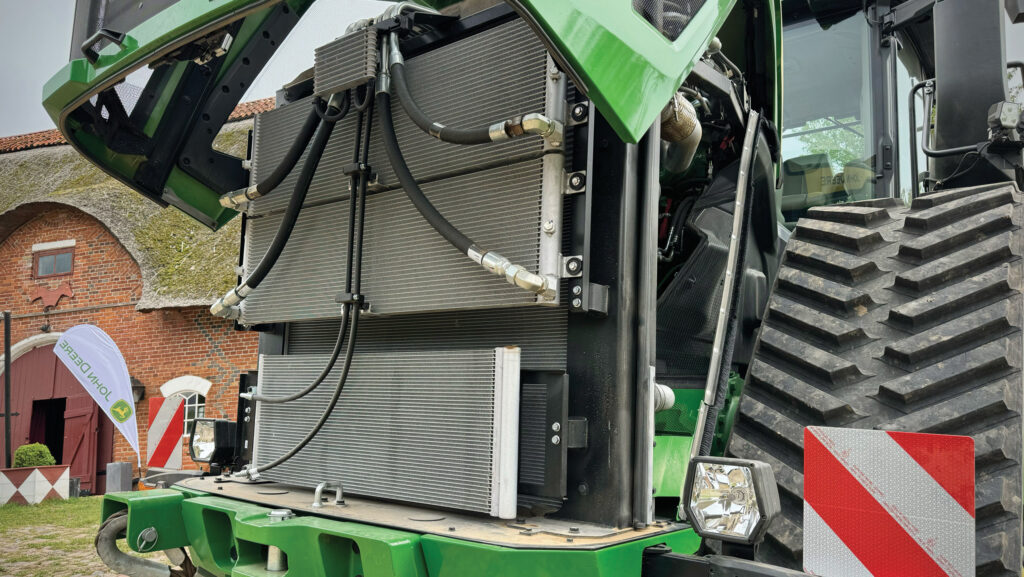
© MAG/Oliver Mark
As a result, the engine should be able to handle diesel with slightly higher sulphur or moisture content, and burn it more efficiently.
It’s all relative, though – spot rates with a 9m Kockerling Vector in tow still hit 166 litres/hour during our stint in the seat.
Quenching this thirst is a swimming pool’s worth of diesel.
Maximum capacity is 1,952 litres (£1,250 of cherry at current prices), though European-spec machines will have their tanks limited to 1,500 litres due to continental road rules.
Fast-fill kits are available to pump 570 litres/min, shortening what would otherwise be an enforced coffee break to just four minutes.
There’s a new transmission, too, with Deere having gone to considerable expense to develop an auto-shifting E21 full powershift specifically for the biggest 9RXs.
This has more ratios, and bigger and stronger gears, than the E18 in the 640. The insane amount of torque rules out a CVT option.
What about the cab?
It is semi-new, with this “Plus” version of the smaller 8R’s Command View 4 gaining 20% more glass and 15% more floor space.
Visibility is remarkably good considering the cab has been lowered, the bonnet is as big as a bus shelter, and there’s an elephant’s leg of an exhaust behind one pillar. Even the drawbar can be seen from the seat.
Underneath lies a new 8RX-style suspension system featuring an isolating subframe that eats vibrations and noise.
The interior fit-out is suitably generous given the stupefying list price.
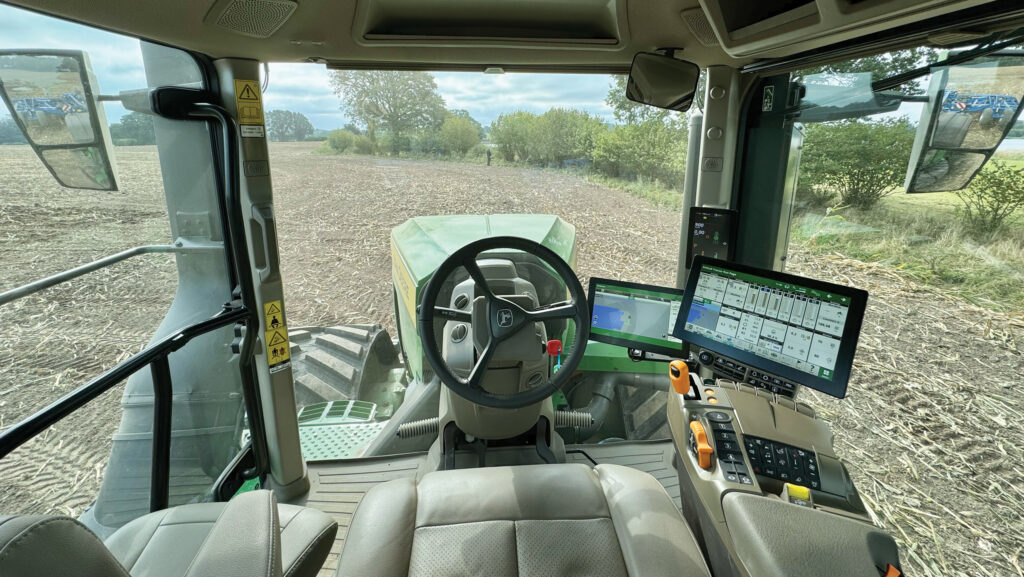
© MAG/Oliver Mark
The seat will heat, ventilate and massage operators’ posteriors and has plenty of swivel, and there’s Apple CarPlay/Android Auto, which has gone down a storm since its introduction on other models.
A 6.8in radio touchscreen in the roof and a G5 Plus display are also included. All it’s missing is a coffee machine.
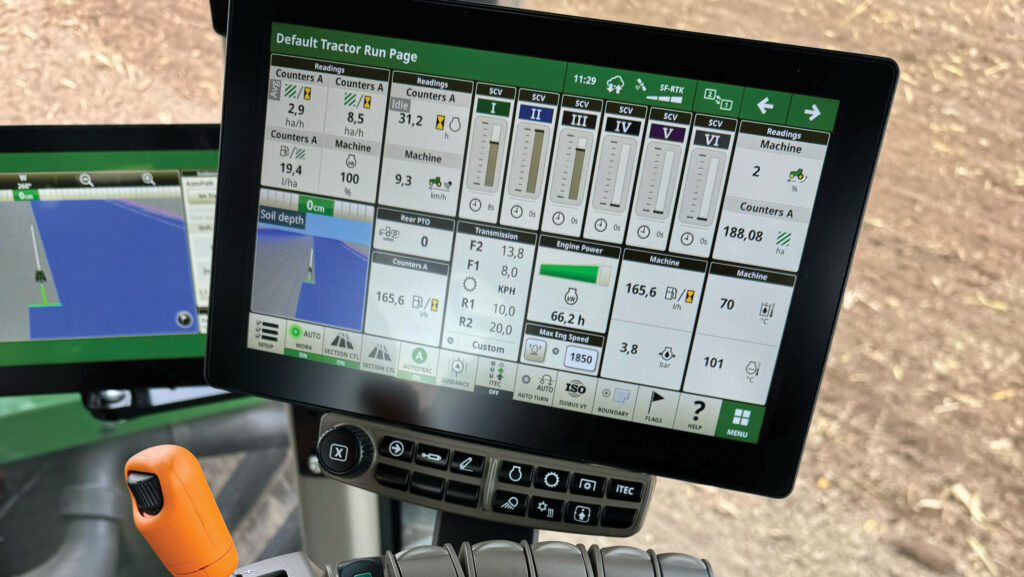
© MAG/Oliver Mark
Whether customer demand really extends to an electric steering wheel – and the complexity that goes with it – is more questionable.
As nice as a steer-by-wire system might be, the ability to tweak the ratio and resistance has few advantages when drivers spend most of their time cruising hands-free.
Weight problem?
On the face of it, Big John’s weight appears a cause for concern.
The big fella ships at 33.5t, can be ballasted to 38.1t, and has a maximum permissible weight of just over 42t – 10t more than the 640, thanks to a new structural chassis.
But weight equals traction in the tillage game and there’s plenty of scope for adding extra metal.
This includes a 1,000kg, forklift-friendly block slung under its hooter and up to 1,600kg on its hind – not forgetting the best part of 2,000kg in the diesel tank.
The track units can also accommodate 455kg wing weights, though these will take the width beyond 3m.
To handle the extra power, the drive wheels have been enlarged by 200mm and now have a bigger wrap angle – the contact area between wheel and track – to put them in contact with more belt lugs.
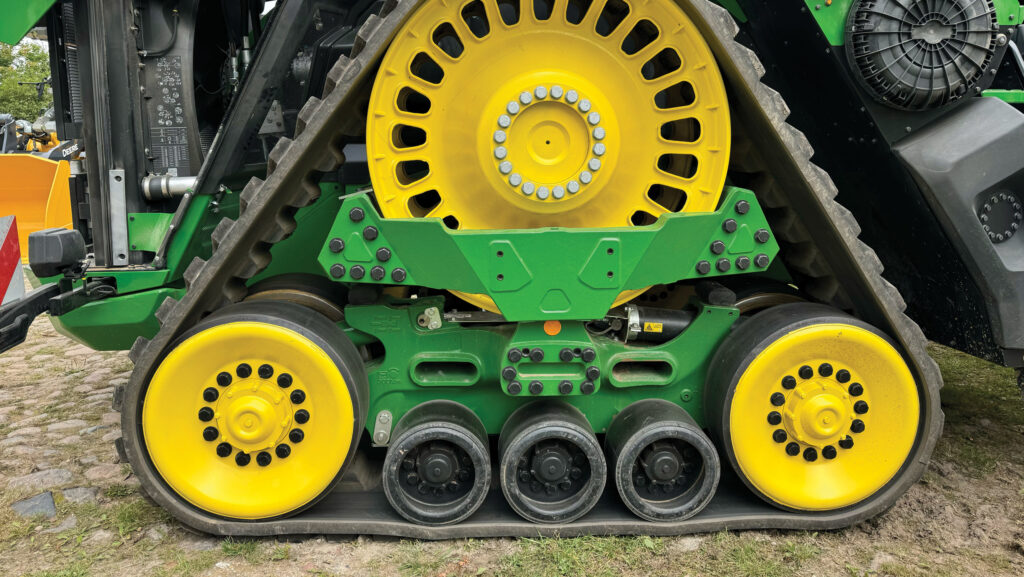
© MAG/Oliver Mark
And the tracks themselves – 30in-wide rubbers from Camso – have a longer footprint that makes room for a third mid-roller.
This distributes the weight over 5.57sq m, which is a smidge down on the 640.
The end result is a soil load of 0.58kg/sq cm, which Deere enthusiastically points out is less than the average male (1.5kg/sq cm).
What about implements?
This is new territory as far as tractor power goes, so implement options – in Europe, at least – are decidedly limited.
Such scant choice is a problem given farmers are increasingly scrutinising cultivators and drills to get the best match for their soil types and farming systems.
Wider, 913hp-friendly versions of existing implement designs will inevitably materialise but, until then, buyers will just have to take what they can get and hope they don’t rip the headstock off.
Farmers Weekly verdict
No doubt Big John eats acres. But that appetite, and the potential efficiency gains that go with it, will only be rewarded if buyers have the field sizes and implement options to match.
One can’t help feeling that manufacturers of these agricultural giants are running out of customers in the UK, with growers increasingly favouring more versatile machines that can be used year-round.
Cue a big sigh of relief for those living down narrow country lanes…
Likes and gripes
Likes
- Copious power and torque
- Comfortable cab
- Surprisingly good visibility
- Easy service access
Gripes
- Weight for road transport
- Limited implement options
- Standard sized toolbox
Autonomy kit coming
These latest 9RXs come with a ruck of precision farming technology, the most intriguing of which is an Autonomy controller built into the cab roof.
In time, this will allow owners to retrofit their tractors with the full driverless package (ie, no one in the seat).
The system is currently being tested on some 60 tractors in the US, all running John Deere implements caked in sensors capable of alerting owners to trash blockages, shear-bolt breakages and the like.
To handle the vast amounts of data being accumulated by both tractor and implement, this prototype model was fitted with a high-speed isobus connection, dubbed “implement ethernet”.
It is capable of processing 1GB/sec, compared with 150KB/sec of standard isobus, as it records the placement of every kernel or grain in the field.
However, the commercial roll-out of this new-age Autonomy package will have to wait until issues regarding insurance and liability are resolved.
Responsibility currently falls on the equipment manufacturer, which John Deere isn’t at all keen on.

